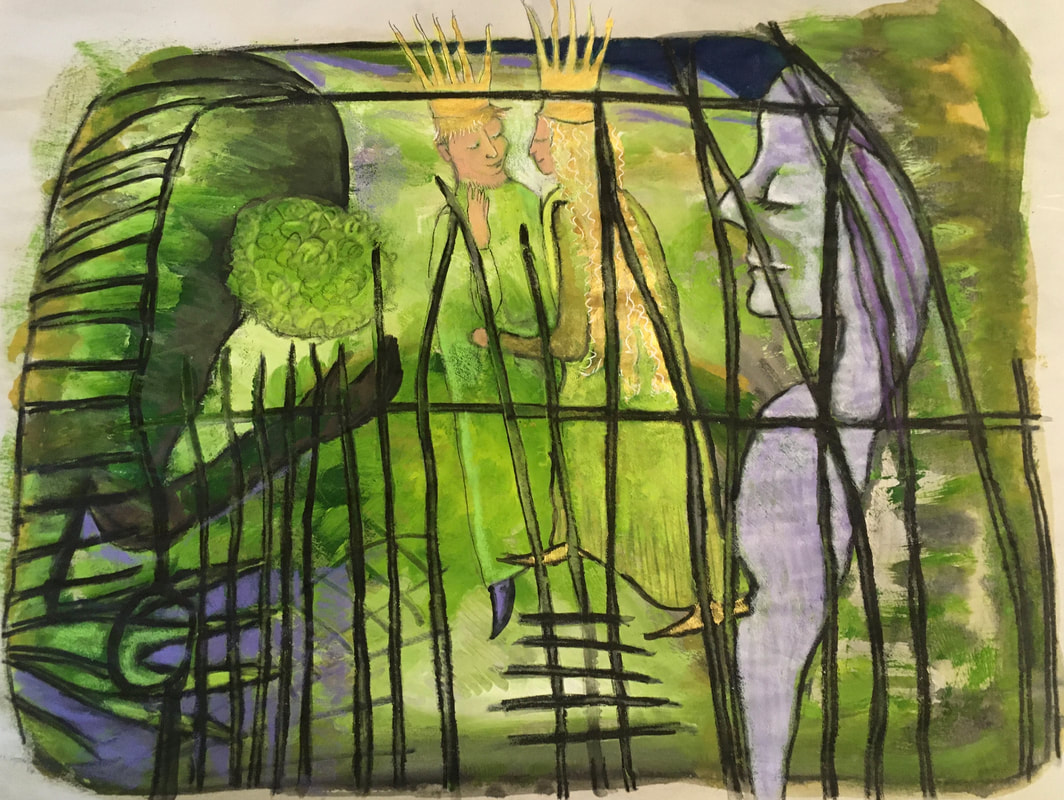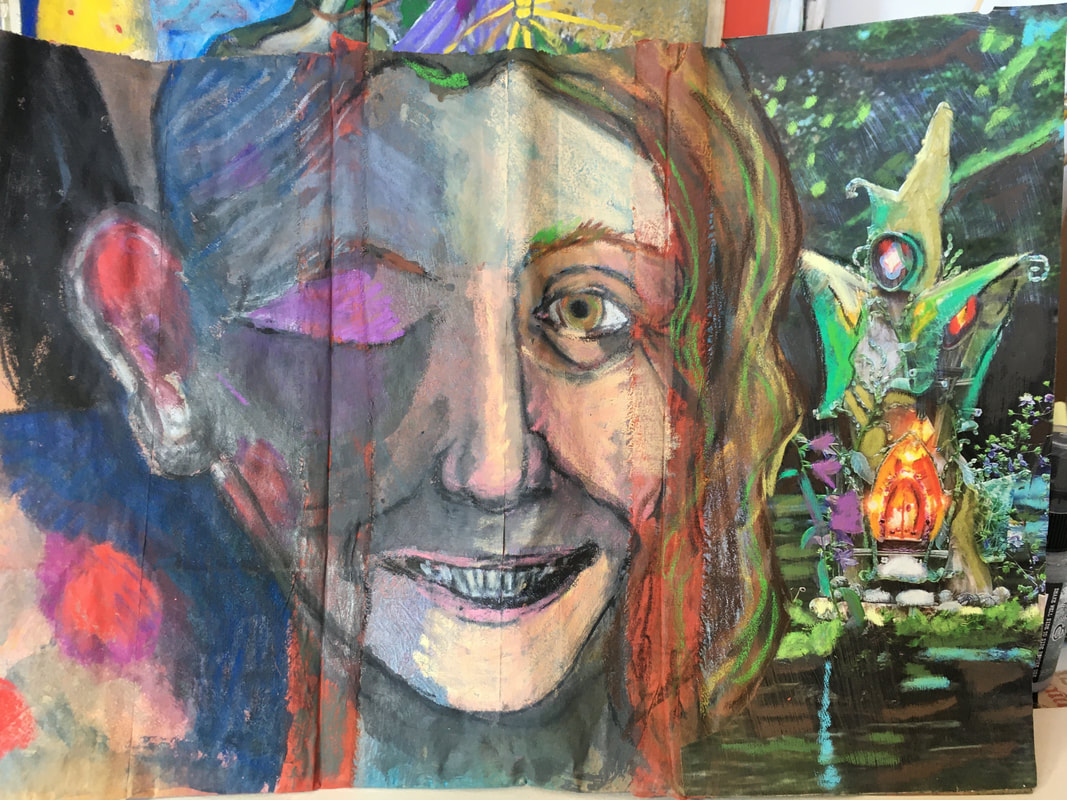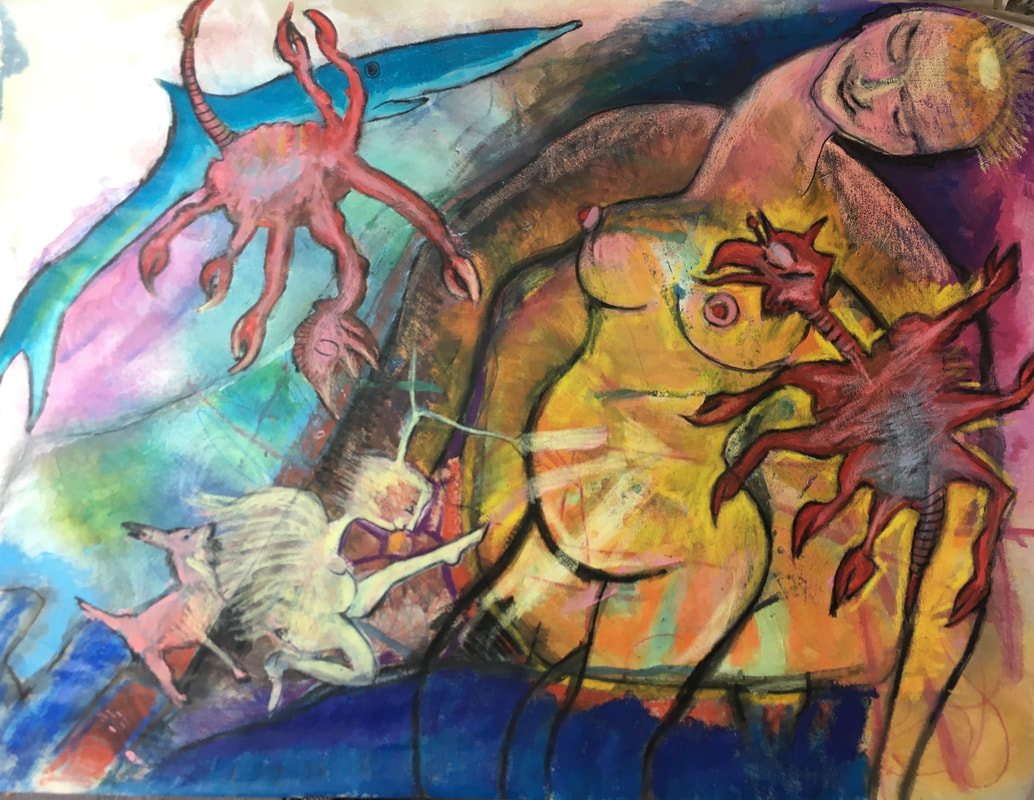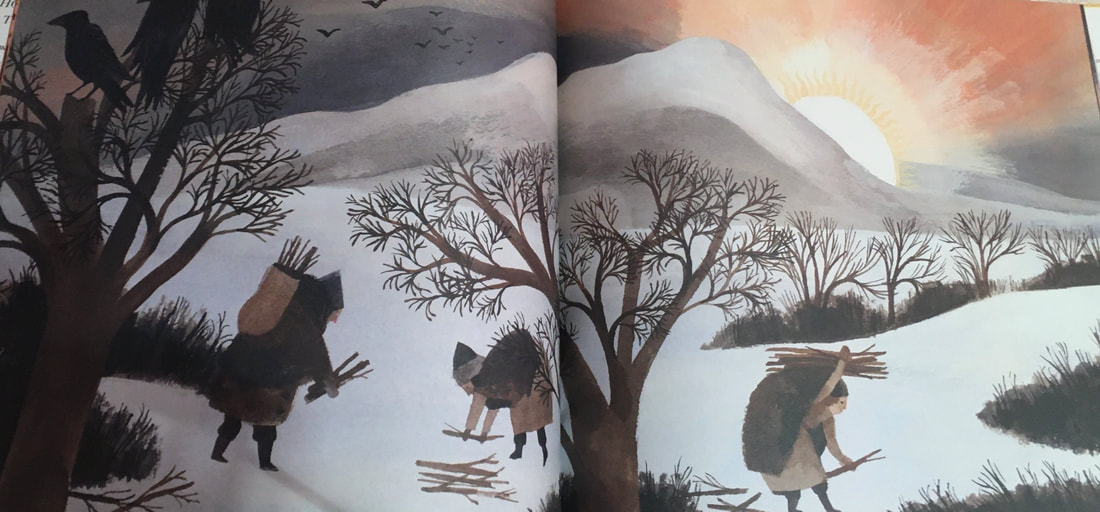|
The messy lineage of the Fierce Feminine For the last couple months, in preparation for an on-line class I am teaching this Spring, I have been immersing myself in myths, fairy tales and lore related to the messy lineage of the fierce feminine. During my lifetime, the last 60 years or so, there has been more interest in the stories of the feminine divine hidden within the patriarchal world religions. There are many books about the feminine face of God written in the past 60 years. These books tell of fierce dark goddesses who were connected to the earth and its rhythms. Yet, sometimes I feel a resistance in myself about embracing these stories. Is it that they sound too “woo woo?” Am I afraid of appearing too “out there” myself? Still, another part of me feels in my bones a connection to these powerful archetypes. And this part of me feels that it is worth taking the risk of embracing the fierce feminine, no matter how foolish or New Agey it might make me appear. The Crone and the Un-nesting instinct For instance, the crone has something to say about an experience that many of us begin to have as mid to late middle-aged women. Our culture speaks often of the nesting instinct of women, our wish to have children and to procreate, our wish to create a home, to nurture those in our care, and to sacrifice our needs for them. But you don’t hear much about the “un-nesting instinct” that comes later in life and that the crone archetype represents so well. At the time of the crone, we take apart our nests, jettisoning all that we no longer need in our lives. This feels necessary and scary at the same time. We are still mothers and yet, our responsibilities have changed. Instead of focusing on those in our care, we turn inward to the riches of our inner world, riches accumulated after years of experiences of caring for others and contributing to society. Now it is time to shed layers of experience, of roles and of expectations and time to begin to live truly for oneself. This can feel kind of uncomfortable and awkward. The famous poem, Warning, that starts, “When I am an old woman, I shall wear purple…” speaks to this instinct to shed all the unnecessary baggage of our lives lived for others, and begin to turn to our true soul identity. The end of the year, with the coming of winter and the solstice can be a good time to meditate on meanings of coming into crone-hood, whether we are fully in the midst of it now, or whether it is an experience far in our future. Because, none of these faces of the divine feminine exist in isolation. Instead, the maiden, mother, crone and death are usually seen as faces of the same central figure. The turning of the year, hope of light at the coming of the dark The winter solstice is the time of year that corresponds with mid to late middle age for women. Along with the coming of winter, this time is celebrated in all the world religions in a similar way, as a time of hoping of light in the midst of darkness. At this time of year, we release what is no longer needed from the previous year. The element associated with this time of year is earth and the direction is north. The crone is strongly associated with the earth and the darkness of the northern climate. She is dark, elemental, and grounded-in-the earth. One such figure is the Dark Madonna, (a dark-skinned representation of the Virgin Mary, often seen as an advocate for the poor and underserved.) She has roots in earlier figures such as Tiamet (Babylonia), Europa (Greek and Roman), Cerridwen/Caillech, the Morrigan, (Celtic) Kali or Durga, (Hindu) and in Eastern European fairy tales, Baba Yaga. Who were these ancient feminine figures? All of these powerful crone-like figures derived energy from the earth itself. They were wild souls, free from constraints of a structured existence. Turning away from society’s norms, they turned towards the healing darkness of the forests, of under the ocean, of caves and of under the earth, where the dark soil rejuvenated itself for the growth of another year. They connected also to the plants and animals that hid themselves in the dark woods and knew how to source their potions and remedies from these places. Stones too were sources of power, not just for the protective qualities of stone caves but also the power contained within the stones themselves. So much mystery here, things we don’t know. Ancient goddesses who in fact, were the earth I mentioned a wide range of seemingly disconnected ancient goddesses above. Some, like Tiamet and Europa were themselves the body of the earth. In ancient stories, it was told that the bodies of these goddesses were torn apart to make the mountains, valleys and waters of the earth. They were in fact, the earth. Instead of an association with the celestial bodies, as their more celebrated male counterparts, they were rooted in the earth and grounded in the cycles of the seasons. Many of their stories had to do with the ways in which they had the power to bring or withhold the warmth of spring and summer. One such story is the Greek and Roman goddess Persephone whose banishment to the underworld for six months out of the year meant the coming of darkness and winter. Where did they go? What is my point in moshing all these various ancient figures together? I am not claiming in any way to be an accurate religious scholar or historian. For those of you more steeped in knowledge of the ancient goddesses, please forgive my inexactitude, in exchange for my enthusiasm. What I am alluding to is the truth that we as women all know in our bones, but was not reinforced in the world around us. Instead, this feminine form of the divine was for centuries strenuously denied and rejected by what Clarissa Pinkola Estes calls the “over-culture.” In the over-culture, a male dominated, hierarchical divine force perpetuated violence, greed and hierarchy. This force destroyed and is destroying the earth under our feet in order to meet its relentless needs. Its hierarchical order was imposed from without. Unfortunately, this is the world we live in today, a world that is most likely to destroy itself in the not-too-distant future. We know in our bodies that there is more than this. Our yearning for a more cyclical, nurturing, regenerating way of living is our turning towards the crone, not only for us as individuals, but also for our planet. Baba Yaga, one of my favorite crone stories One of my favorite figures of the crone archetype of the dark feminine is Baba Yaga, from Eastern European folk tales. I can’t presume to be able to describe her many guises because there are so many stories about her, and they originated from oral narratives. But she represents to me the way in which the crone holds such rich inspiration for us as women. She carries within her some of the elements most common to the crone archetype. She lives in a way that is one with the forces of nature around her and derives strength from nature, rejecting the norms imposed on women, especially older women, by society. One of her symbols is the cauldron, most often associated with crones, symbol of the ability to gestate, create, dream. She is fierce and feared. She lives far away from “civilized” life. She, like many crone figures, is often demonized and denigrated and yet, for those who are brave enough to meet her, she carries wisdom and truth. An archetypal figure of the crone, Baba Yaga One does not go out and seek Baba Yaga. Rather, you surrender and in your lostness, you come upon her. And it helps if you have the right intentions, if you seek her out of true curiosity and innocence. She immediately senses falseness and greed. In one of my favorite stories about Baba Yaga, the person who finds her is a young girl called “Vasilisa the Brave.” This young girl is sent, in one version of the story, into the forest to get fire from Baba Yaga, by her wicked step-mother, who intends for Vasilisa to be killed. The step-mother wants to get rid of Vasilisa. But luckily, Vasilisa has, in her pocket, a wise doll that had been given to her and blessed by her mother on her deathbed. (Here are also the elements of the maiden, mother and crone in the story all at once) This wise doll is able to guide Vasilisa through her visit with Baba Yaga, so that she knows what to ask, what to do. Impressed with the respect and care with which Vasilisa interacts with her, Baba Yaga doesn’t kill and eat her, but instead, after Vasilisa completes all the tasks she is given, Baba Yaga gives her a skull with magic flames coming out of its eyes. Using this magic flaming skull, Vasilisa vanquishes her step-mother and nasty step sisters. The point is, the fierce feminine is potentially dangerous but if handled with the utmost respect and with some intelligence as well, one can gain great wisdom and power from interacting with her. In her own way, Baba Yaga is still a guide and protector. What is it like to encounter your own inner crone? What permissions do you give yourself when you allow this crone being to come into your consciousness? What is it time to clear out now? If you are inspired, take some time now to reflect on what you are ready to let go of, whether on a physical level, as in clutter, or emotional level, to-do lists that no longer apply, relationships that no longer serve or spiritual level, creating spaciousness for what might want to come in at this time. Release these in a silent meditation, either sitting in a meditative space in your home, or a silent nature walk. The Shortest Day by Susan Cooper
And so the Shortest Day came and the year died And everywhere down the centuries of the snow-white world Came people singing, dancing, To drive the dark away. They lighted candles in the winter trees; They hung their homes with evergreen; They burned beseeching fires all night long To keep the year alive. And when the new year’s sunshine blazed awake They shouted, reveling. Through all the frosty ages you can hear them Echoing behind us—listen! All the long echoes, sing the same delight, This Shortest Day, As promise wakens in the sleeping land: They carol, feast, give thanks, And dearly love their friends, And hope for peace. And now so do we, here, now, This year and every year. Welcome, Yule!
3 Comments
sharon
12/29/2021 06:31:11 am
Al I can say is thank you for sharing this. Feeling the all ness of it moving into the marrow of bones, into all of me.
Reply
Erika
12/29/2021 10:04:11 am
Thanks so much, Sharon! I am so glad that this hit home for you.
Reply
11/23/2023 04:00:11 pm
How is a Bone Marrow Transplant Performed?
Reply
Leave a Reply. |
ErikaI've been making dolls for about ten years now. I believe that dolls serve as representations and reminders of the best part of ourselves. I am excited to share with you here my learnings about new methods and techniques for doll making and healing. So glad you are here! Categories |




 RSS Feed
RSS Feed